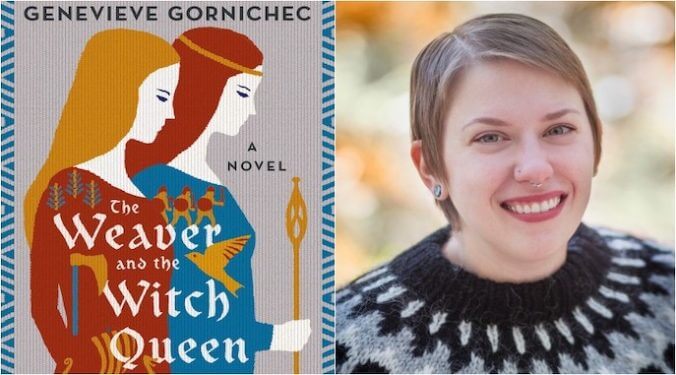The Weaver and the Witch Queen’s Genevieve Gornichec on Putting Historical Women Center Stage
Photo: Daina Faulhaber
Genevieve Gornichec’s The Weaver and the Witch Queen is a remarkable novel for many reasons: Its richly conceptualized world that deftly weaves a thread of magic through historical fact, its unapologetic dedication to centering female and marginalized perspectives, and its wide array of fascinating characters, who all have distinct arcs and goals of their own. Gornichec’s determination to tell stories about the women who are often forced to linger at the margins of the lives of historical men (or, worse, who are blamed for their various problems and failings) is not only admirable but necessary. (And it makes for a compelling read at the same time.)
The Weaver and the Witch Queen is a historical fantasy retelling of the life of the woman who would be known in the Norse sagas as Gunnhild, Mother of Kings. In those tales, she’s almost universally remembered in a negative light, often disparaged as unnatural and assumed to be a witch for daring to hold power in a traditionally male world. In Gornichec’s version, she’s a woman trying to exert agency over her own life in limited ways available to her, and neither she nor her author makes any apologies for that.
We got the chance to have a long, rambling (ridiculously fun) chat with Gornichec herself about The Weaver and the Witch Queen, Norse sagas, female representation in historical stories, the real Erik and Gunnhild and so much more.
![]()
The following has been edited (somewhat) for length and clarity. [And to remove the staggering amount of tangents that result when early medieval literature nerds nerd out.]
Paste Magazine: The Weaver and the Witch Queen is your second novel and your second book that takes inspiration from some aspect of Norse epic poetry, folklore, or mythology. What is it about this period of history that appeals to you so much?
Genevieve Gornichec: I first got really into this when I was studying the Old Norse language in college, and literally the day that I stepped into that classroom, it changed my life. Because before then I didn’t really know anything about Vikings or any of that. And I had lived in Sweden for four months because my grandfather is from Sweden. So when I was in college, I decided to apply for a scholarship to study abroad. I was over there for a semester, and then I came back and was like, well, I’ll do a Scandinavian studies minor now because I lived in Scandinavia. One of the only classes that semester that was available was Old Norse. So literally, if that class had not been offered that semester when I got back to the States, I might be a completely different person.
Paste: This is also your second book that takes a mythological or historical female figure who really only existed in the margins—usually of a man’s story—and brings them out into their own. I mean, look, I’m not going to front like I didn’t watch or love shows like Vikings or Vikings: Valhalla or that I don’t enjoy the sort of current pop culture trend of historical shows full of female characters just kicking ass.
But it also often feels very grounded in, I think, a male idea of what a female butt-kicking Viking lady would look, like versus coming from an actual place in the source material. I would love to hear about how you went about finding their voices in the text and making these women feel true to themselves, rather than a sort of male gaze ideal.
Gornichec: Everything you just mentioned, I could literally talk the rest of the time just about, because this is my pet peeve. Basically, we are treating these historical women as only cool if they can pick up a sword and beat a guy up.
And I want to preface this by saying that I think that in 2023, anybody of any gender should be able to live their best life authentically without being bullied or harassed for being too masculine or too feminine. In 2023, if you want to be empowered by Lagertha? Right, awesome. Amazing. However, I think we run into problems where, like you said, the only things we think are cool are physical violence, basically. And it goes back to this whole idea of us… “Oh, equality is women doing anything men can do.” But why isn’t the opposite true? Why do people still make fun of men who are sensitive or feminine?
-

-

-

-

-

-

-

-

-

-

-

-

-

-

-

-

-

-

-

-

-

-

-

-

-

-

-

-

-

-

-

-

-

-

-

-

-

-

-

-








































